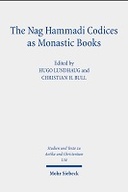Explore

The Nag Hammadi Codices as Monastic Books
0 Ungluers have
Faved this Work
Login to Fave
Since their discovery in 1945, the significance of the texts contained in the thirteen papyrus manuscripts now known as the Nag Hammadi Codices has been fiercely debated. In the history of scholarship, the texts have primarily been analyzed in light of the contexts of their hypothetical Greek originals, which in a majority of cases have been thought to have been authored in the second and third centuries CE in a variety of contexts. The articles in this volume take a different approach. Instead of focusing on hypothetical originals, they ask how the texts may have been used and understood by those who read the Coptic papyrus codices in which the texts have been preserved and take as their point of departure recent research indicating that these manuscripts were produced and used by early Egyptian monastics. It is shown that the reading habits and theological ideas attested historically for Upper Egyptian monasticism in the fourth and fifth centuries resonate well with several of the texts within the Nag Hammadi Codices.
This book is included in DOAB.
Why read this book? Have your say.
You must be logged in to comment.
Rights Information
Are you the author or publisher of this work? If so, you can claim it as yours by registering as an Unglue.it rights holder.Downloads
This work has been downloaded 35 times via unglue.it ebook links.
- 35 - pdf (CC BY-NC-ND) at Unglue.it.
Keywords
- Aspects of religion (non-Christian)
- Biblical Studies
- Criticism & exegesis of sacred texts
- Humanities
- New Testament
- Religion
- Religion & beliefs
- Sacred texts
- thema EDItEUR::Q Philosophy and Religion::QR Religion and beliefs
- thema EDItEUR::Q Philosophy and Religion::QR Religion and beliefs::QRV Aspects of religion::QRVC Criticism and exegesis of sacred texts
Links
DOI: 10.1628/978-3-16-162233-5Editions

